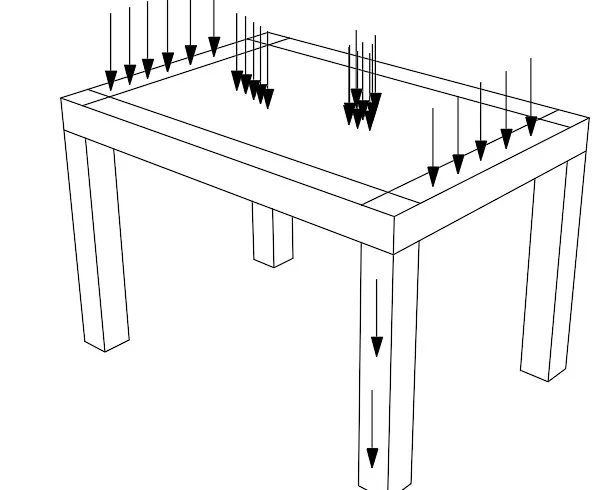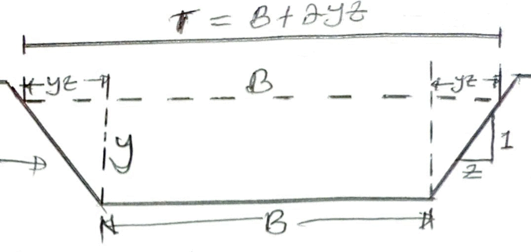Types of supports and their Characteristics/ their applications.
The type of support provided for a structure is important in ensuring its stability. Supports connect the member to the ground or to some other parts of the structure.
There are three basic idealized support structure types, categorized by the types of deflection they constrain: roller, pinned, fixed, hanger and simple support.
- Roller supports.
- Pinned support.
- Fixed support.
- Hanger support.
- Simple support.
- Varieties of support.
Roller supports

This is the type of support which only restrains the structure from moving in one or two perpendicular directions. However, the structure can move in the other directions and it can also rotate. The joint that is supported by a roller support has four or five degrees of freedom.
If the structure acts as a two-dimensional system, the roller support restrains the node form moving in one direction only. In general, there is a support reaction (force acting from the support to the structure) in the direction of the restrained degree of freedom. Therefore, roller supports have one or two support reactions. Roller supports are used in bridges and spatial structures to allow for thermal movements.
Roller supports are often used with other types, such as fixed or sliding supports, to provide a stable and secure foundation for a structure. They are particularly useful in situations where the supported object is subject to lateral loads, as they allow the object to move or rotate in response to these forces, reducing the stress on the structure. Roller supports are also used in various other applications, including conveyor belts, rolling mills, and material handling systems. They can be generated in determinate and indeterminate structures. They are typically made of materials such as steel or other high-strength metals and are designed to withstand the loads and stresses associated with their intended use.
Examples of Roller Supports
Roller supports to allow the movement of a structure or object along a fixed path. Examples of roller supports include conveyor belts, sliding doors, and roller coasters. Here are a few more examples of how roller supports are used:
Bridges: Roller supports are commonly used in the construction of bridges to allow for movement or rotation of the bridge deck in response to applied loads. The roller supports allow the bridge to move or rotate slightly, reducing the stress on the structure and increasing its stability.
Cranes: Roller supports are also used in constructing cranes to allow for the rotation of the boom and other parts of the crane. The roller supports allow the crane to rotate and move freely while providing a stable and secure foundation for the structure.
Conveyor belts: Roller supports are used in conveyor belts to support and guide the movement of the belt. The roller supports allow the belt to move smoothly and continuously while providing a stable foundation for the belt and the materials being conveyed.
Rolling mills: Roller supports are used in rolling mills to support and guide the movement of the rolls. The roller supports allow the rolls to rotate and move freely while providing a stable foundation for the rolls and the materials being processed.
Material handling systems: Roller supports are used in material handling systems to support and guide the movement of materials. The roller supports allow the materials to move smoothly and continuously while providing a stable foundation for the materials and the handling equipment.
Pinned supports

Pin or hinge support is used when we need to prevent the structure from moving or restrain its translational degrees of freedom. Most supports for architectural structures (except concrete structures) are of this type. When used for spatial structures, these supports have three reactions; however, there are only two reactions in two-dimensional structures.
Also known as Hinged supports are typically used when it is necessary to allow for rotational movement of a structure or object, but not necessarily translation (movement in a straight line). They are often used with other types of supports, such as roller or fixed supports, to provide a stable and secure foundation for a structure. Hinged supports are typically made of materials such as steel or other high-strength metals and are designed to withstand the loads and stresses associated with their intended use. They are also commonly used to construct joints in robotics and other mechanical systems.
Examples of Hinged Supports
Hinged supports, also known as pivot points or pin joints, allow for rotational movement around a fixed point. Hinged support includes hinges on doors, folding tables, and the human elbow joint. Here are a few examples of how hinged supports, also known as pin joints or hinges, are used:
Machinery: Hinged supports are also used to construct various types of machinery, such as presses and other manufacturing equipment, to allow for rotational movement and adjust the machinery. The hinges allow the machinery to rotate and move freely while providing a stable and secure foundation.
Bridges: Hinged supports are used in the construction of certain types of bridges, such as swing and bascule bridges, to allow for rotational movement of the bridge deck. The hinges allow the bridge deck to rotate around a fixed axis, allowing the bridge to open and close to allow the passage of boats or other vessels.
Doors: Hinged supports are commonly used to construct doors to allow for rotational movement around the hinges. The hinges allow the door to swing open and close while providing a stable and secure connection between the door and frame.
Gates: Hinged supports are also used to construct gates to allow for rotational movement around the hinges. The hinges allow the gate to swing open and close while providing a stable and secure connection between the gate and the gate posts.
Cranes: Hinged supports are used in constructing cranes to allow for rotational movement of the boom and other crane parts. The hinges allow the crane to rotate and move freely while providing a stable and secure foundation for the structure.
Fixed supports

Fixed supports are points of a structure that do not allow movement or rotation. The support reactions at fixed support can be calculated using the principles of statics and the structure’s known loads and support reactions. The sum of all forces and moments at fixed support must equal zero for the structure to be in equilibrium. Here are a few examples of how fixed supports, also known as pinned supports or fixed joints, are used:
Bridges: Fixed supports are commonly used in the construction of bridges to prevent movement of the bridge deck along a particular axis while still allowing for rotational movement around the support. The fixed supports provide a stable and secure connection between the bridge deck and the bridge piers, preventing the bridge from collapsing under the applied loads.
Buildings: Fixed supports are also used in the construction of buildings to prevent movement of the structure along a particular axis while still allowing for rotational movement around the support. The fixed supports provide a stable and secure foundation for the building, preventing it from collapsing under the applied loads.
Machinery: Fixed supports are used in the construction of various types of machinery, such as presses and other manufacturing equipment, to prevent movement of the machinery along a particular axis while still allowing for rotational movement around the support. The fixed supports provide a stable and secure foundation for the machinery, allowing it to operate smoothly and reliably.
Robotics: Fixed supports are also used in the construction of joints in robotics and other mechanical systems to prevent joint movement along a particular axis while still allowing for rotational movement around the support. The fixed supports provide a stable and secure connection between the components of the system, allowing it to operate smoothly and reliably.
Roller Support Reactions
Roller support is a type of support used in construction and engineering to support a structure or object. It consists of a cylinder or roller designed to rotate around a central axis, allowing the supported object to move or rotate freely. When a structure or object is supported by roller support, the support reacts to the loads applied to the structure or object in a specific way. The reaction forces at roller support depend on the type of loads applied to the structure or object and the position of the roller support relative to the loads. Generally, roller support will react to applied loads with vertical and horizontal forces and a moment (rotational force).
Applications of Different Types of Support
Different types of supports, such as roller supports, fixed supports, and hinged supports, are used in various applications to support structures and objects and allow for movement or rotation as needed. Here are some examples of how these different types of supports are used:
Roller supports: Roller supports are used in various applications where it is necessary to allow for the movement or rotation of a structure or object. Examples include bridges, cranes, conveyor belts, rolling mills, and material handling systems. Roller supports to allow the structure or object to move or rotate freely while providing a stable and secure foundation.
Hinged supports: Hinged supports, also known as pin joints or hinges, are used in various applications where it is necessary to allow for rotational movement around a fixed axis. Examples include doors, gates, bridges, cranes, and machinery. Hinged supports to allow the structure or object to rotate and move freely while still providing a stable and secure connection between the structure or object and the support.
Fixed supports: Fixed supports are used in various applications where it is necessary to prevent the movement of a structure or object along a particular axis while still allowing for rotational movement around the support. Examples include bridges, buildings, fixed beams, and various types of machinery. Fixed supports provide a stable and secure connection between the structure or object and the support, preventing the structure or object from collapsing under applied loads.




